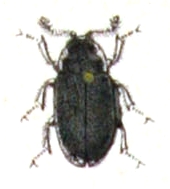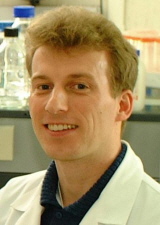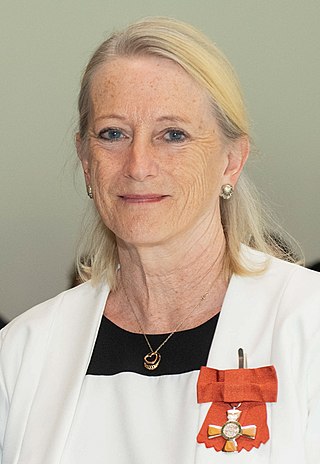Related Research Articles
A microsatellite is a tract of repetitive DNA in which certain DNA motifs are repeated, typically 5–50 times. Microsatellites occur at thousands of locations within an organism's genome. They have a higher mutation rate than other areas of DNA leading to high genetic diversity. Microsatellites are often referred to as short tandem repeats (STRs) by forensic geneticists and in genetic genealogy, or as simple sequence repeats (SSRs) by plant geneticists.

Intercalated discs or lines of Eberth are microscopic identifying features of cardiac muscle. Cardiac muscle consists of individual heart muscle cells (cardiomyocytes) connected by intercalated discs to work as a single functional syncytium. By contrast, skeletal muscle consists of multinucleated muscle fibers and exhibits no intercalated discs. Intercalated discs support synchronized contraction of cardiac tissue in a wave-like pattern so that the heart can work like a pump. They occur at the Z line of the sarcomere and can be visualized easily when observing a longitudinal section of the tissue.
Amelogenins are a group of protein isoforms produced by alternative splicing or proteolysis from the AMELX gene, on the X chromosome, and also the AMELY gene in males, on the Y chromosome. They are involved in amelogenesis, the development of enamel. Amelogenins are type of extracellular matrix protein, which, together with ameloblastins, enamelins and tuftelins, direct the mineralization of enamel to form a highly organized matrix of rods, interrod crystal and proteins.
Forensic identification is the application of forensic science, or "forensics", and technology to identify specific objects from the trace evidence they leave, often at a crime scene or the scene of an accident. Forensic means "for the courts".

Sodium/potassium/calcium exchanger 5 (NCKX5), also known as solute carrier family 24 member 5 (SLC24A5), is a protein that in humans is encoded by the SLC24A5 gene that has a major influence on natural skin colour variation. The NCKX5 protein is a member of the potassium-dependent sodium/calcium exchanger family. Sequence variation in the SLC24A5 gene, particularly a non-synonymous SNP changing the amino acid at position 111 in NCKX5 from alanine to threonine, has been associated with differences in skin pigmentation.
A ringtest for quality management is part of an external quality assurance programme for a measuring method. Ringtest is also called proficiency test or interlaboratory test. Usually a reference institute sends identical samples which have to be analyzed for special parameters to different laboratories. The industrial, medical or research laboratory gets a limited time with a deadline to send in the analysis results. The statistical evaluation and interpretation of the laboratories’ results is a great help for all participating labs as it opens the possibility to assess the quality of their analysis compared to other laboratories. Participation in ringtests is obligatory for accredited laboratories. Nevertheless, non-accredited laboratories can also take part in ringtests.

Forensic biology is the use of biological principles and techniques in the context of law enforcement investigations.
Cadaveric spasm, also known as postmortem spasm, instantaneous rigor mortis, cataleptic rigidity, or instantaneous rigidity, is a rare form of muscular stiffening that occurs at the moment of death and persists into the period of rigor mortis. Cadaveric spasm can be distinguished from rigor mortis as the former is a stronger stiffening of the muscles that cannot be easily undone, while rigor mortis can.

Haplogroup T-M184, also known as Haplogroup T, is a human Y-chromosome DNA haplogroup. The unique-event polymorphism that defines this clade is the single-nucleotide polymorphism known as M184.

Body identification is a subfield of forensic science that uses a variety of scientific and non-scientific methods to identify a body. Forensic purposes are served by rigorous scientific forensic identification techniques, but these are generally preceded by formal identification. This involves requesting a family member or friend of the victim to visually identify the body.
John M. Butler is a scientist and expert on forensic DNA profiling. He is a fellow at the National Institute of Standards and Technology. Since 2020, he serves as president of the International Society for Forensic Genetics.

Dermestes frischii is a species of beetle found in the Palearctic, including Europe, tropical Africa, the Near East, the Nearctic, North Africa and East Asia. In Europe, it is known from Albania, Bosnia and Herzegovina, Bulgaria, Corsica, Croatia, the Czech Republic, mainland Denmark, European Turkey, Finland, mainland France, Germany, mainland Greece, Hungary, mainland Italy, Kaliningrad, Moldova, North Macedonia, mainland Norway (doubtful), Poland, Russia, Sardinia, Sicily, Slovakia, mainland Spain, Sweden, Ukraine and Yugoslavia.
Bernd Brinkmann is a German forensic pathologist.

The International Society for Forensic Genetics – ISFG is an international non-profit scientific society founded in 1968. The main goal of the society is to advance the field of forensic genetics, also termed DNA profiling, through dissemination of scientific results and opinions, communication amongst scientists and education. The bi-annual international ISFG congresses, international workshops and seminars, the society’s scientific journal, and the scientific recommendations on current topics all work towards this goal. The society’s website contains up to date information on all activities.

The Y Chromosome Haplotype Reference Database (YHRD) is an open-access, annotated collection of population samples typed for Y chromosomal sequence variants. Two important objectives are pursued: (1) the generation of reliable frequency estimates for Y-STR haplotypes and Y-SNP haplotypes to be used in the quantitative assessment of matches in forensic and kinship cases and (2) the characterization of male lineages to draw conclusions about the origins and history of human populations. The database is endorsed by the International Society for Forensic Genetics (ISFG). By May 2023 about 350.000 Y chromosomes typed for 9-29 STR loci have been directly submitted by worldwide forensic institutions and universities. In geographic terms, about 53% of the YHRD samples stem from Asia, 21% from Europe, 12% from North America, 10% from Latin America, 3% from Africa, 0.8% from Oceania/Australia and 0.2% from the Arctic. The 1.406 individual sampling projects are described in about 800 peer-reviewed publications

Peter Forster FRSB is a geneticist researching the prehistoric origins and ancestry of mankind. In addition to archaeogenetics, he has published on the reconstruction and spread of prehistoric languages and in the field of forensic genetics.

Chrysomya marginalis, the regal blowfly, also referred to as the regal bluebottle or the bordered blowfly is an uncommon and relatively large species of fly that was described by Weidemann in 1830. It is found in Africa to the south of the Sahara, and is also found in various Middle-Eastern countries.

Peter Matthias Schneider was a German forensic geneticist. He was a full professor at the Institute of Legal Medicine of the University of Cologne.

8,11-Dihydroxytetrahydrocannabinol (8β,11-diOH-Δ9-THC) is an active metabolite of THC, the main active component of cannabis. The 8β enantiomer retains psychoactive effects in animal studies with only slightly lower potency than THC, while the 8α enantiomer is much weaker. Both enantiomers have a shorter half-life in the body than 11-Hydroxy-THC, making 8,11-dihydroxy-THC potentially useful for drug testing to distinguish between recent cannabis use and use longer in the past.

SallyAnn Harbison is a New Zealand forensic scientist. She leads the forensic biology team at the Institute of Environmental Science and Research, and is an associate professor at the University of Auckland. Harbison was appointed a Member of the New Zealand Order of Merit in 2021 and in the same year was elected as a Fellow of the Royal Society Te Apārangi.
References
- ↑ "Stain Commission" . Retrieved April 19, 2020.
- ↑ "Peter M. Schneider" . Retrieved December 8, 2023.
- ↑ Schneider, P. M.; Fimmers, R.; Keil, W.; Molsberger, G.; Patzelt, D.; Pflug, W.; Rothämel, T.; Schmitter, H.; Schneider, H.; Brinkmann, B. (2008). "The German Stain Commission: recommendations for the interpretation of mixed stains". International Journal of Legal Medicine. 123 (1): 1–5. doi:10.1007/s00414-008-0244-4. ISSN 0937-9827. PMID 18604547. S2CID 12642867.
- ↑ "Stain Workshops" . Retrieved April 19, 2020.